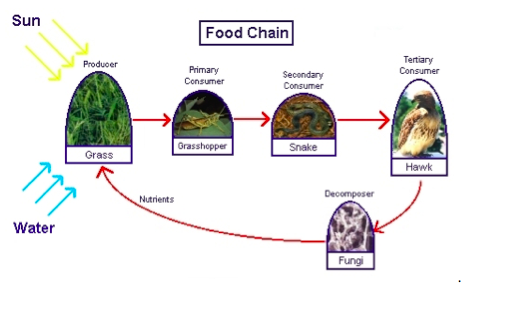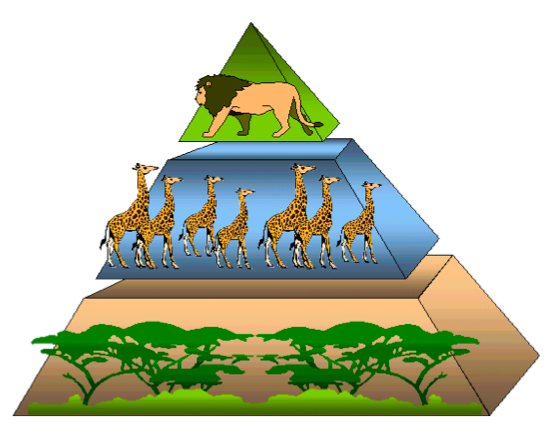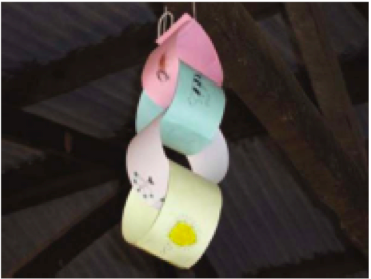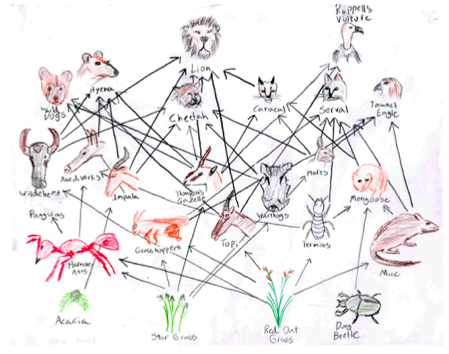Lesson 4: Food Chains
Jump To
- Objectives
- Background
- Materials
- Vocabulary
- Preparation
- Procedure
- Discussion
- Possible Questions
- Extension
Print this Page
Additional Resources
Objectives
Students will learn about food chains, pyramids, and food webs. Students will also learn how all of nature is connected and dependent on each other.
Background
A food chain shows how each living thing gets its food. Some animals eat plants and some animals eat other animals. For example, a simple food chain links the trees and shrubs, the giraffes (that eat trees and shrubs), and the lions (that eat the giraffes). Each link in this chain is food for the next link. All food chains start with energy from the sun. This energy is captured by plants. Thus the living part of a food chain always starts with plant life and ends with an animal.

Plants are called producers because they are able to use light energy from the sun to produce food (sugar) from carbon dioxide and water. Animals cannot make their own food so they must eat plants and/or other animals. They are called consumers. There are three groups of consumers. Animals that eat only plants are called herbivores (or primary consumers). Animals that eat other animals are called carnivores. Carnivores that eat herbivores are called secondary consumers, and carnivores that eat other carnivores are called tertiary consumers. Animals and people who eat both animals and plants are called omnivores. Then there are decomposers (bacteria, fungi, and even some worms), which feed on decaying matter. These decomposers speed up the decaying process that releases mineral salts back into the food chain for absorption by plants as nutrients.
In a food chain, energy is passed from one link to another. When a herbivore eats, only a fraction of the energy (that it gets from the plant food) becomes new body mass; the rest of the energy is lost as waste or used up by the herbivore to carry out its life processes (e.g., movement, digestion, reproduction). Therefore, when the herbivore is eaten by a carnivore, it passes only a small amount of total energy (that it has received) to the carnivore. Of the energy transferred from the herbivore to the carnivore, some energy will be “wasted” or “used up” by the carnivore. The carnivore then has to eat many herbivores to get enough energy to grow. Because of the large amount of energy that is lost at each link, the amount of energy that is transferred decreases each time. The further along the food chain you go, the less food (and hence energy) remains available.
Food chains can also be represented in different forms such as this pyramid.

The above energy pyramid shows many trees and shrubs providing food and energy to giraffes. Note that as we go up, there are fewer giraffes than trees and shrubs and even fewer lions than giraffes. As we go further along a food chain, there are fewer and fewer consumers. In other words, a large mass of living things at the base is required to support a few at the top. Many herbivores are needed to support a few carnivores. Most food chains have no more than four or five links. There cannot be too many links in a single food chain because the animals at the end of the chain would not get enough food (and hence, energy) to stay alive.
Most animals are part of more than one food chain and eat more than one kind of food in order to meet their food and energy requirements. These interconnected food chains form a food web. Food chains can get complicated because animals usually eat a variety of food.
Materials
Food Chains
- Enough strips of colored paper so that each student has four, one on which to draw the sun, one on which to draw a producer, one on which to draw a primary consumer and one on which to draw a secondary consumer.
Food Web
- Blank cards
- Colored pencils
- Yarn
Vocabulary
- Carnivore: an organism that eats mostly meat
- Consumer: an organism, usually an animal, that feeds on plants or other animals
- Food chain: a sequence of organisms arranged in such a way that each feeds on the organism below it in the chain and serves as a source of food for the organism above
- Food web: all the connected or linked food chains within an ecological community
- Herbivore: an organism that eats mostly plants
- Predator: an animal that lives by killing and eating other animals
- Producer: an organism, usually a plant, that converts sunlight energy into living material; usually the first step on the food chain or food web or first trophic level of a food pyramid
Preparation
Cut enough strips of paper so that each student will have four. Cut the yarn into pieces that will connect species that interact with each other.
Procedure
Food Chains

On the blackboard, write the following headings: Producers, Primary Consumers, Secondary Consumers, and Tertiary Consumers. Ask students to name some species under each heading. Then demonstrate how to create a food chain, using some of the species listed.
Once students understand, have them draw the sun, a producer, a primary consumer, a secondary consumer, and a tertiary consumer on each of their four strips.
These should then be interlocked and glued together to make a chain of species in which one eats the other. They can be hung from the rafters to illustrate the diversity of food chains that exist in nature.
Food Webs
Note: This activity can be added for older students.
Start as with food chains, putting the three headings on the board. Have students name species under each heading and tell something about each species’ lifestyle. Then have each student choose a species from the board, write its name on a card, and draw a picture of it. (Check each one off the list as it’s chosen, to make sure it’s only used once). Then the student should poke a hole near the bottom of the card.
Begin the food web by attaching a picture of the sun at one side of the wall. (If you put it on a wall, it can be saved). Have the students who drew producers bring their cards up. Hang these in a horizontal line next to the sun and attach each one to the sun with a piece of yarn to show the connection. Then have students who drew primary consumers bring their cards up. Hang these in a horizontal line above the producers.

One at a time, discuss which producers they would each consume. Attach yarn from each primary consumer to the producers it would consume. (Remember that most animals eat more than one kind of food). The students will begin to see how complex a food web is. Next add the secondary and tertiary consumers in rows above the producers. Again, discuss the connections between primary, secondary, and tertiary consumers. Next add the scavengers: hyenas (can be predators as well as scavengers) and vultures. Finally, discuss decomposers—bacteria, fungi and worms that feed on the decaying matter—and their role in the food web. Students should now have a complete understanding of the complexity of the food web. At right is an example of a food web.
Discussion
All living things need energy to stay alive. This energy comes from the sun. Plants make their food from energy from the sun. Animals get their energy from the food they eat. Animals depend on other living things for food. Some animals eat plants while others eat other animals. This passing of energy from the sun to plants to animals to other animals is called a food chain.
Possible Questions
- Do you know why there are more herbivores than carnivores?
- What if one animal from the food chain disappeared? What about one level of the food chain? Producers? Decomposers? Herbivores?
- How do humans fit in the food chain?
- What could happen if an animal not native to an area is brought into the local food chain?
- What could happen if you remove an animal from the food chain?
- How can sun and rain affect the food chain? Drought?
- Why is a food web a more accurate depiction of nature than a food chain or pyramid?
Extension
1. Web of Life
Objective:
Students will understand the concept of a food chain and demonstrate a grassland’s food chain.
Materials:
- Pictures of animals, river, tree, grass, sun
- A ball of yarn/spool of twine
Procedure:
Read The Great Kapok Tree, by Lynne Cherry. Ask students to name all the different animals that are dependent on the one tree.
Give each participant a picture.
First demonstrate a food chain, a simple interdependence, by linking the student with the sun card (the source of all energy) to the student with the grass card to the student with the zebra card to the student with the lion card.
Show the impacts of man on the simple food chain. Man can:
- Cut trees (no trees, nothing for grazers to eat, grazers will die, lions and other predators will have nothing to eat. They will start to eat our livestock.)
- Hunt in excess (If we kill the lions, there will be too many zebras and they will need more grass. They will eat the grass from our pasturelands.)
Balance is key! Explain that the interactions in a grasslands system are more complicated than this. For example, the sun provides for more than just grass, and lions don’t only eat zebras.
Have the participants now stand in a circle, out of order (i.e. not all of the producers together, then the primary consumers, then the secondary consumers, etc.)
Give the ball of string to the person with the sun. Then ask that person to pass the yarn to the person with a card of an organism that the sun supports. If the sun supports more than one organism in the circle, pass the string back to the sun and from the sun to the other organism that it supports.
Continue by asking the plants which organisms they can support and so on.
Keep going through the chain until you get to the top consumers. The string will be a tangled web in the middle of the circle. Food chains are complicated, and the balance they create is essential.
Again discuss the impacts of man on the web by having students drop their string if man’s impact kills off their organism. For example, the impact of overhunting will cause the lions to drop their strings. What happens?
Possible Questions
- Do you know why there are more herbivores than carnivores?
- What if one animal from the food chain disappeared? What about one level of the food chain? Producers? Decomposers? Herbivores?
- How do humans fit in the food chain?
- What could happen if an animal not native to an area is brought into the local food chain?
- What could happen if you remove an animal from the food chain?
- How can sun and rain affect the food chain? Drought?
- Why is a food web a more accurate depiction of nature than a food chain or pyramid?
2. Food Chain Tag
This activity requires a large open area. In a class of 25 to 40 students, choose three to five to be predators and seven to ten to be plant-eaters. The remainder will be plants. This represents a balanced system where plants are more plentiful than plant-eaters, plant-eaters more plentiful than predators, and predators are the least plentiful. The students can select which plant-eaters and predators will be in their groups. (Example: Grevy’s zebras are plant-eaters and lions are predators).
Each group selects hand-signals that will differentiate them from the other groups. (Example: the plants may want to hold their hands out to their sides to represent leaves, the plant-eaters (oryx) may hold their hands on the heads to represent horns, and the predators (lions) may hold their hands up like paws with the claws showing). The predators try to tag the plant-eaters who try to tag the plants. Since predators decompose when they die and become fertilizer, the plants try to tag the predators. Once you are tagged, you turn into whatever tagged you.
After a period of time, stop the game to see how many plants, plant-eaters, and predators are left. Play should resume but should be stopped a few times before the end to determine what has happened and why. After playing a few rounds of the game, select one of the plants to re-enter the game as a human. The rules for the human are different: the human can tag anyone, but no one can tag the human. Each time the human tags someone, that player becomes another human. See how long it takes before all players have become changed into humans.
Discuss the changes and relationships that the game illustrates. Some questions for discussion might include:
- What happens to the plants and plant-eaters if many of the predators have been caught?
- What happens to the plants if many of them have been caught?
- What happens when humans use too much of the food chain? How can we keep that from happening?
- Ask students to record what happened in their science notebooks, including an illustration of the food chain they represented. Talk about the adaptations the various organisms would have to develop in order to survive if one of the species in the food chain became extinct.
